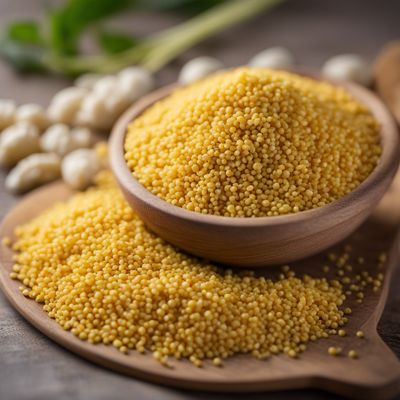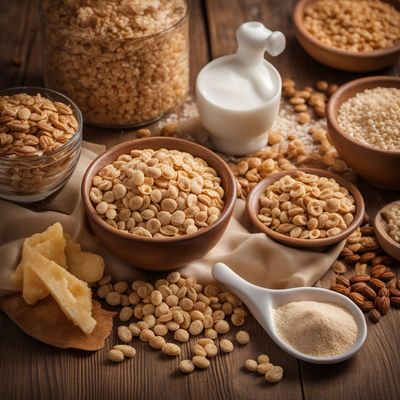
Ingredient
Flour mix (like wheat/rye/barley/oats and other)
Versatile Blend for Every Recipe
A flour mix is a combination of different grains, such as wheat, rye, barley, oats, and other cereals. This versatile blend offers a unique flavor profile and texture, making it suitable for various culinary applications. It can be used to create delicious bread, pastries, pancakes, cookies, and more, providing a wholesome and hearty base for countless recipes.
Origins and history
The concept of flour mixes dates back to ancient civilizations, where different grains were ground together to create a more balanced and nutritious flour. This practice allowed people to make the most of the available resources and create versatile ingredients that could be used in a variety of dishes. Today, flour mixes are widely used in baking and cooking, offering a convenient and flavorful alternative to single-grain flours.
Nutritional information
A flour mix is a good source of carbohydrates, dietary fiber, and essential minerals like iron and magnesium. It provides a balanced combination of nutrients from different grains, contributing to a well-rounded diet. The nutritional content may vary depending on the specific grains included in the mix.
Allergens
There are no known allergens associated with a flour mix. However, individuals with gluten intolerance or celiac disease should opt for gluten-free flour mixes that exclude wheat and other gluten-containing grains.
How to select
When selecting a flour mix, look for a reputable brand that offers a high-quality product. Check the ingredient list to ensure it includes a variety of grains, such as wheat, rye, barley, oats, and others. Consider your specific dietary needs and preferences, such as opting for organic or gluten-free options if necessary. Additionally, pay attention to the packaging date to ensure freshness.
Storage recommendations
To maintain the freshness and quality of a flour mix, store it in an airtight container in a cool, dry, and dark place. Avoid exposure to moisture, heat, or direct sunlight, as these can affect the texture and flavor of the flour mix. Proper storage will help extend its shelf life and preserve its nutritional value.
How to produce
Producing a flour mix at home requires a grain mill or a high-powered blender capable of grinding various grains into a fine powder. Start by selecting the desired grains, such as wheat, rye, barley, oats, and others. Measure the grains in the desired proportions and grind them together until a fine flour consistency is achieved. Store the homemade flour mix in an airtight container to maintain its freshness.
Preparation tips
A flour mix can be used as a substitute for single-grain flours in various recipes. It provides a unique flavor and texture, enhancing the overall taste of the dish. However, keep in mind that the specific characteristics of the flour mix may differ from individual grains, so adjustments may be needed in terms of liquid ratios or baking times.
Substitutions
A flour mix is a versatile ingredient that can be used in a wide range of culinary creations. It is commonly used in baking bread, pastries, cakes, cookies, and pancakes, providing a wholesome and flavorful base. The combination of different grains adds complexity to the taste and texture of the final product, making it a favorite among home bakers and professional chefs alike.
Culinary uses
Flour mixes are commonly available in grocery stores, supermarkets, and specialty food stores worldwide. They can also be purchased online, offering a convenient option for those seeking specific brands or variations of flour mixes.
More ingredients from this category » Browse all

Maize, milled
Golden Grain: Unleashing the Power of Milled Maize

Amaranth flour
The Ancient Grain Flour with a Nutty Twist

Buckwheat flour
The Nutty Powerhouse: Buckwheat Flour

Wheat flour
The Versatile Grain: Exploring the Wonders of Wheat Flour

Millet flour
The Ancient Grain: Millet Flour

Cereal and cereal-like flours not separately listed
The Flour Power: Unleashing the Versatility of Cereal and Cereal-Like Flours

Sorghum flour
Sorghum Flour: A Nutritious and Gluten-Free Alternative

Rice flour
The Versatile Grain Powder

Spelt flour
The Ancient Grain of Spelt

Oat flour
The Wholesome Power of Oat Flour

Rye flour
Hearty Grain

Barley flour
The Nutritional Powerhouse: Barley Flour
